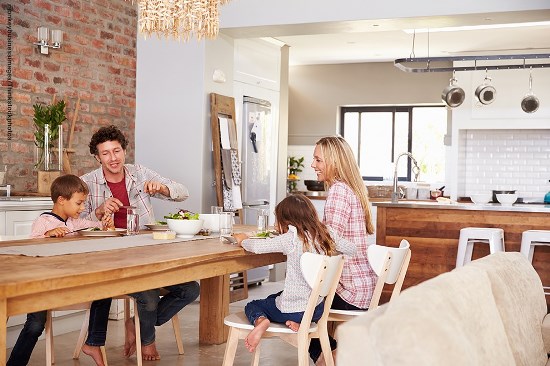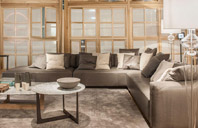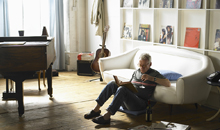LivingScapes: Contemporary styles of life and living (Part I)
Source:Salone del Mobile.Milano Trend Lab
LivingScapes is the research conducted by the Salone del Mobile.Milano Trend Lab – the new research lab and intelligence center of the Salone del Mobile – to identify the principal international trends in the world of design, furniture and living.

The home is the most intimate yet also the most social place in which we live our lives. Lifestyles are in continuous evolution, and it is in the home – the theater and stage of our daily experience – that the most significant socio-economic, technological and cultural changes manifest themselves, fruit of the advanced present we live in, and of our imagined future.
LivingScapes is the research conducted by the Salone del Mobile.Milano Trend Lab – the new research lab and intelligence center of the Salone del Mobile – to identify the principal international trends in the world of design, furniture and living. The aim is to study evolving lifestyles and predict which will become indispensable in the future so as to then imagine products capable of satisfying new living needs, both inside and outside the home. The socio-cultural approach and ethnographic research method distinguish the study thanks to their capacity to see the world-home as an object-place inhabited by individuals with personal and relational needs that evolve with the changes in society, in our image of the world, in lifestyles and in the socio-economic context.
The various meanings of contemporary living will this find a declension in trends, in turn described through ways of living that find expression in the objects that the home contains, that furnish and fill it.
The home, which is the focus of this study, is considered in its dual dimension as HOUSE – the physical and structural space and tools – and as HOME – lived space and the behaviors, inclinations, ideas and choices that organize the space and govern performance, interactions with objects, gestures, rituals and relationships.
The objective, at once sociological and anthropological, is to identify and understand the individual and social meanings of the home as a place in a state of continual change that reflects lifestyles, which are also constantly transforming.
“Inhabiting is like coming into the world, and coming into the world is already inhabiting”, writes Maurizio Vitta in Dell’abitare (Einaudi, 2008). “What we call ‘life’ contains this indissoluble correspondence with inhabiting from the outset”.
The experience of living/inhabiting consists of four main elements: bodies, which is to say people, the primary subjects of living; spaces, the physical places and constructions where living is organized and develops; objects, the furnishings, utensils and ornaments that integrate our living spaces; and the images through which the esthetic character of living is expressed.
Objects narrate our happiness, for example, according to the Turkish Nobel Prizewinning author Orhan Pamuk: “No one recognizes the happy moments of their lives as they are living them. Only the possession of an object can remind us of those precious moments, more faithfully than the people who gave them to us”.
Objects, things – as indigenous peoples have always known – are animated in the same way as people, they are proxies of strong relationships, next to us. And they are capable of telling about us.
As the philosopher Walter Benjamin argues in La merce è sogno – 1966, goods and objects are endowed with a magical component. Possessing them liberates a form of happiness that recalls childhood, play and the dimension of dreams. Goods and objects have an oneiric quality that helps transfigure reality.
Today, the home has assumed a new centrality in contemporary social experience and represents a mirror not only of new esthetic and expressive trends, but the behavior and lifestyle of those who live there. It is a porous container, more open than ever to innovations and contaminations from the ‘outside’, a “hyperworld’ that is permeable to the new experiences of consumption, in turn enriched by new uses and meanings. It is an instrument of self-extension that responds to the needs and desires of people who, through their homes as through fashion, express their own social identity.
The objects and furnishings of the home have an existential value, because they are signs, ideas, symbols of identity.
The home is the narration of those who live in it. Inhabitants imbue spaces and objects with a meaning that goes beyond architecture and design, because the irreducible subjectivity of living comes into play. Indeed, it is above all ‘things’ that make a home. There is an interesting dual connection between the inhabitants and the ‘things’ therein. The personality of those who live there is unintelligible without the background of the furnishings. “These things are here because I am here”.
It is precisely from the observation of the artifacts and projects contributed by architects, designers and interior designers that the Salone del Mobile Trend Lab analyzes the uses and meanings, both functional and identitary, that people attribute to them in their daily lives, in response to specific needs and desires.
As the privileged space of the expression of self, the home changes and evolves alongside contemporary social and cultural shifts. Economic crisis, the main driver of change in recent years, has determined the emergence of number of new practices and habits – swapping, self-production, DIY, etc. – which have found fertile ground in the home.
The digital revolution and the emerging paradigm of the sharing economy (Airbnb, social eating, etc.) are redesigning and giving new meaning to private spaces with a view to increasingly pushing the boundaries towards public space, i.e. the home as an important hub of the sociosphere (Edgar Morin).
New technologies have made homes hyperconnected, transforming them first of all into the new workplaces, as well as adaptive ‘organisms’ existing somewhere between the physical and digital worlds.
The home is therefore a multifaceted universe, ever more layered with the experiences of the people who live, work, play, spend their time, cultivate their relationships and build their identities and biographies within its walls.
(Source: Salone del Mobile.Milano Trend Lab)





 沪公网安备31010402003309号
沪公网安备31010402003309号



